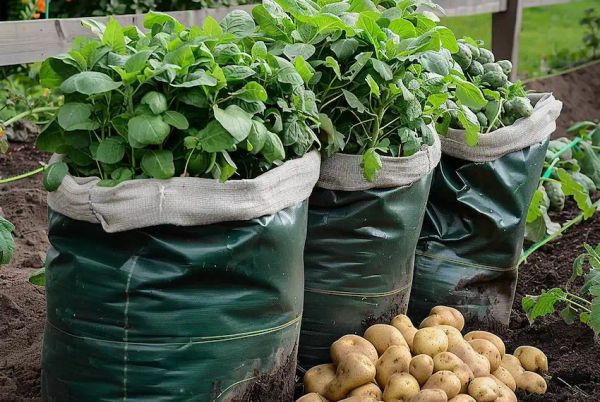Are you interested in growing your own potatoes? Not only is it rewarding, but it can also be a fun activity. Did you know that you can grow potatoes in sacks?

This space-efficient method not only saves space, but it can also significantly increase your potato yield. In this step-by-step guide, we will show you how to grow sacks full of potatoes using a simple and effective trick that will ensure a bountiful harvest.
Benefits of Growing Potatoes in Sacks
There are several advantages to growing potatoes in sacks:
Space Efficiency: If you have a small garden or even a balcony, growing potatoes in sacks is ideal. It allows you to make the most of your limited space.

Ease of Harvest: Say goodbye to digging! Simply tip the sack over when it’s time to harvest your potatoes. It’s that easy!
Pest Management: By growing potatoes in sacks, you reduce the risk of soil-borne pests. This means healthier plants and a higher chance of a successful harvest.
Soil Control: With sacks, you have control over the soil conditions. You can create the perfect environment for your potatoes to thrive.

Materials Needed
To get started, here’s what you’ll need:
- Large, sturdy sacks (burlap or a similar breathable material)
- High-quality potting soil
- Seed potatoes
- Compost or well-rotted manure
- Watering can or hose
- Fertilizer (optional)
Now that you have everything you need, let’s dive into the step-by-step guide.

Step-by-Step Guide to Growing Potatoes in Sacks
Step 1: Choose the Right Seed Potatoes
Select certified seed potatoes known for their productivity and disease resistance. Before planting, allow them to sprout by placing them in a light and cool place.
Step 2: Prepare Your Sacks
Roll the sides of the sacks down to half their height. This makes it easier to add soil and plant your potatoes. Remember to create drainage holes in the bottom of the sacks to ensure proper water flow.
Step 3: Layer Soil and Potatoes
Start by adding a layer of about 4-6 inches of a mixture of potting soil and compost or manure to the bottom of the sack. Place your seed potatoes about 5 inches apart on top of the soil. You can start with 3-5 seed potatoes, depending on the size of your sack.
Step 4: Cover and Wait
Once you have placed the seed potatoes, cover them with another 4-6 inches of soil. Make sure the soil is moist but not waterlogged. Water the sack thoroughly.
Step 5: Keep Adding Soil
As the potato plants grow and reach about 12 inches in height, roll up the sides of the sack and add more soil to cover the bottom third of the plant. Repeat this process until the sack is full. This technique, known as “hilling,” encourages more tubers to form along the buried stems.
Step 6: Watering and Care
Potatoes require a consistent amount of moisture. Water the plants regularly, especially during dry spells. If desired, you can apply a balanced, slow-release fertilizer every four weeks to support growth.
Step 7: Watch for Pests and Diseases
Regularly inspect your potato plants for signs of pests or diseases. By choosing resistant varieties and ensuring good air circulation around the sacks, you can minimize common issues like potato blight.
Step 8: Harvesting
When the foliage starts to die back and turn yellow, it’s time to harvest your potatoes. Stop watering the plants to allow the potatoes to cure for a few days before harvesting. To collect your potatoes, simply tip the sack over and sift through the soil.
The Surprising Trick: Coffee Grounds
Here’s a trick that will amaze you: Add coffee grounds to your soil mixture. Potatoes thrive in slightly acidic soil, and coffee grounds are acidic. Additionally, coffee grounds add organic material, improving soil structure and health. Mix coffee grounds into your potting soil to increase acidity and deter soil pests.
Growing potatoes in sacks is an excellent method for anyone looking to save space and reduce garden maintenance. By following these detailed steps and incorporating the simple trick of using coffee grounds, you’ll be amazed at how easy it is to harvest a bumper crop of potatoes right from your backyard or even a balcony. This method not only simplifies the growing process but also makes it more enjoyable and productive.




